In 2018, a new mayor tasked Newham’s housing company with building more affordable homes. Seven years later, it’s getting ready for its biggest scheme yet. Daniel Gayne headed east to find out more.

Curving southwards away from the River Lee Navigation, Carpenters Road cleaves a path through the middle of the vast Olympic development; the London Stadium, aquatics centre, and East Bank on one side, Westfield, East Village and Queen Elizabeth Park on the other. This is one of the most intensively redeveloped corners of the capital and it has become a symbol of both the good and bad of major regeneration.
But follow the road on, under the railway bridge, and you will find yourself on the Carpenters Estate, a world away from the biodiverse greenery of the Olympics site. Here, 2012 was both an unfulfilled promise and an ominous sign of coming gentrification. “They got a lovely new road, and then nothing else,” says Duncan Hayes, senior communications manager at Populo Living. “Everything else stayed the same as it was from the 1960s.”
From the window of his boss’ office on the upper floors of a building on Stratford High Street, Hayes and I can just about spot the tops of the three residential towers of the Carpenters Estate. It’s a fitting vista. Populo Living is Newham’s wholly-owned housing company and while it has spent the past seven years building more than 800 homes across the borough, it has always had one eye on Carpenters. Regeneration of the estate, set to begin later this year, will be the biggest test yet for its development model, through which it aims to use profit to achieve public good.
Populo has been honing its approach since 2018, when it was created in its current form. That year saw Rokhsana Fiaz take over as Newham mayor from Sir Robin Wales in an open selection battle following an intra-party dispute over the Labour veteran’s initial automatic reselection for the candidacy. Fiaz promised a major refocus in housing policy.
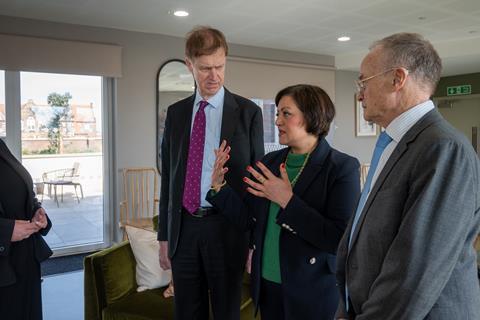
“The model of housing delivery prior to me becoming the mayor, was a model that looked at drawing on an asset base owned by the council to deliver homes for the private rented sector,” Fiaz tells ��Ȧ’s sister title Housing Today.
Instead, she wanted to focus more on delivering affordable homes, beginning with the transformation of Newham’s wholly-owned housing company. Red Door Ventures had been set up in 2014 by Wales as a way of generating revenue for the council’s budget through the development of build-to-rent homes.
Under the new regime, and with a new name, the housing company would continue to build and operate private sector BTR, but instead of profits being ploughed into social care and other council expenses, they would be ringfenced within the organisation to subsidise the affordable units that Populo was now also tasked with building. It now operates 795 homes, of which 251 are affordable units managed by its registered provider Populo Homes (most of these are let at London Affordable Rent, with 16 shared ownership also under management, but the figure does not include 75 affordable later living units which are managed by the council). Going forward, it is planning to focus on delivering for social rent.
Populo’s chief and her vision for development in Newham
To lead the organisation, the council brought in a chief executive with housing experience in both the public and private sector. Deborah Heenan led the housing team in the prime minister’s delivery unit under Tony Blair before a secondment with two major housebuilders.
In our conversation, the Northern Irishwoman is keen to emphasise both the similarities and differences between Populo and a typical developer. On the financial side, she stresses that the organisation faces the same pressures and duties to pay its debts and interest as a private sector developer. “The difference is where they’re paying back the interest, and there’s a slug of money going to shareholders in the form of dividend, that dividend in our case is expressed through rental discounts,” she says. According to the company, they work on a margin of around 14% - the result of a 6% contractor fee being subtracted from the typical volume builder margin of 20%. Heenan says it is “quite right” that private developers are mindful of their own shareholders, but that in developing council-owned land are answerable to “Newham shareholders” and must therefore think about what outcomes local residents want in the long term.
It is not just the use of this dividend, but also the control over the type and quality of housing that distinguishes a firm like Populo. She gives the Noele Gordon House scheme as an example. “The market incentivises that site to be used just for straightforward flats – that’s the beginning and the end of it,” she explains. Instead of that, Populo used the Treasury green book options appraisal to compare a number of different options for developing the site and found that using it for later living “won hands down”. The knock-on health and social care costs of over-55s living in unsuitable homes might not factor into market decisions, but it does affect Newham’s finances.
Designed by the Stirling Prize-winning Mae Architects, Noele Gordon House scheme comprises 75 affordable homes set across two short towers, linked by a communal terrace. It’s ‘secure by design’, meaning only fob-holders can use the lifts, and built according to HAPPI principles (a design criteria for age-inclusive housing), with wide and light corridors where neighbours can stop to talk and big hallways within homes to store mobility vehicles.
The flats have generous balconies on the sides of the builders, away from the polluted road. On each tower they face inwards, towards one another and over the terrace, to engender a sense of community. Like almost all the Populo developments I look around, there’s nothing particularly flashy or attention grabbing about the architecture. But it is attractive, sturdy and sensitive to the style of the surrounding area – in a word, it’s nice.
Populo’s ‘tapestry’ of small schemes across the borough
It has now completed 19 developments across Newham. It tries to maximise affordable rent but this doesn’t necessarily mean building the tenure into every scheme. All 182 apartments at the recently completed Plaistow Hub are market rent but profit generated will fund 112 affordable units elsewhere.
Most of its developments so far have been low-rise and there is a real hodge-podge of typologies, reflecting the odd bits of land and property the council happens to own or acquire. “Where parcels of land come up, what the opportunities are, whether we can make something of it,” Duncan Hayes tells me as he shows me around a few of them. “If we can, we will. So it’s a kind of a tapestry.”
There’s the three old firefighters’ cottages on Nelson Street that have been refurbished to provide six modern flats; there’s The Eves, where eight newly built shared ownership homes provide a striking modern interpretation of a classic terrace house; and then there’s the recently completed Town Hall Annexe, where two floors have been added slightly ungracefully to an Art Deco civic building to make space for 37 apartments.
The openness to third party capital is a significant change - one which reflects the current Labour government’s interest in financial partnerships between the public and private sectors
The historic design of the common spaces in the Annexe, such as the corridors and staircase, is incredibly elegant, and the new outdoor courtyard is spacious, although it must be said that the one-bed flat I’m shown is pretty pokey for £1,650 a month. “Obviously we are very much dictated to by the form of the building in something like this where it is a conversion,” says Hayes, clearly noticing my visible reservations. The annexe forms the second phase of the Didsbury development, with the affordable and market new builds flats put up in the first phase being notably more spacious.
But the prospects for housing development have changed a great deal since 2018, and not wholly for the better. This is forcing Populo to tweak how it does business. As its group business plan for 2025/26 acknowledges, the company was incorporated “at a time of ultra-low interest rates” that no longer prevails. On top of that, it recognises that in part relating to soaring temporary accommodation costs. Previous business plans’ assumptions of “relatively unlimited levels of council investment” have been abandoned, with the current strategy aspiring to turn Populo into “a platform and partnership vehicle for third party investment in housing”, by transitioning from being a design and build company developing homes for Populo Living towards provision of development management services for Newham.
Heenan downplays this change as a technical matter of where risk sits, stressing that “the relationship with the council is the same as ever [and] what my guys do out on the floor is the same as ever”. But there’s no denying that the openness to third party capital is a significant change - one which reflects the current Labour government’s interest in financial partnerships between the public and private sectors. Heenan says that from the research they have done so far, pension funds “feel like a much better fit” than other potential financiers, and argues that a relationship with such funds would be essentially the same as its relationship with the council. The business plan also talks about Populo “playing to its strengths as an expert in the development of new homes and places” and Heenan suggests they could begin to offer their services to other local authorities outside Newham

This period of upheaval has meant a pause in new starts for Populo. Accounts for the year to 31 March 2024, published earlier this year, showed 320 completions but no new starts. Heenan again downplays this, noting that “development is just very lumpy”, although she acknowledges that the new second staircase regulations and the implementation of the ��Ȧ Safety Act have not helped.
Populo has some sites in the pipeline that went back to the drawing board owing to the former, while its Pier Road and Cyprus schemes – which are meant to start on site “towards the end of 2025” according to the business plan – are currently in the middle of the delay-dogged Gateway 2 process.
Despite this, she remains positive and focused on what Populo, the wider industry and government can do to innovate their way out of trouble. “Life has got harder on three fronts,” she says, citing regulations, build costs, and interest rates. “So what can we do in the face of that?”. In her eyes, the answer is greater standardisation.
Developing a more predictable build process without ‘scaring the horses’ on design
Populo has been looking at how it can create a “more predictable” building product “under the bonnet”. The benefit of such an approach, she says, is that it would make the build process easier for contractors, but also that it would enable product suppliers to scale up and deliver at cheaper prices. “If you’re a window supplier and you know that there’s a kit of parts, and these guys are, over the next 20 years, going to be ordering millions of windows, and they’re all going to come in one of five sizes, that makes production so much easier,” she says.
“We already do some of it without thinking, because we don’t have random sized bricks, but we have random sized windows, with no particular benefit that we can see, because they’re not wildly different - they’re out by five centimeters, but that makes it really expensive.”
As well as build cost, Heenan says greater standardisation has the potential to simplify planning, although this would require regulatory change. “Where we want to get to is get a planning passport for what’s under the bonnet, and then that gives you huge savings,” she says, using an automotive analogy to explain. “Volkswagen owns Lamborghini, they own Audi - under the bonnet, it’s the same chassis that’s once tested with the regulator.” This would require the national government to adopt a similar approach to Ireland and Wales, which she admits would mean winning a difficult argument with the public.
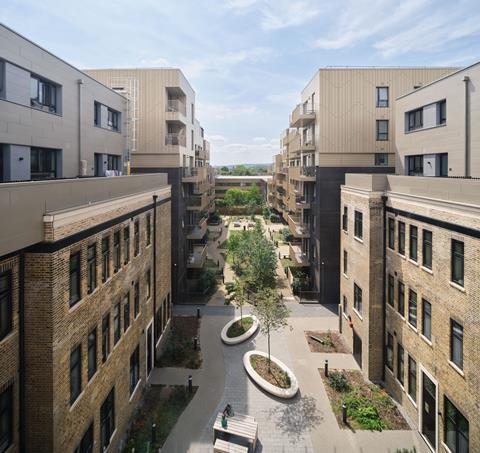
The key, she says, is not “scaring the horses” on design. “If it’s in Norfolk, it might have some Flint detail, if it’s Cambridge, it might be buff brick, if it’s here in London, it might be London brick,” she says, while emphasising that the Georgian and Victorian buildings so beloved by the public were built to a great degree of standardisation. Heenan remains tight-lipped on whether she thinks such a move by the central government is likely. “Watch this space,” she says.
After the recent pause in new starts for Populo, 2025 will see it gear up for delivery again. The real big beast is the Carpenters.
Ready for the big one: Populo’s plans for more than a decade of development at Carpenters Estate
Interviewed by OnLondon in 2018, ex-mayor Wales said of the Carpenters that the council “can’t do it on its own”, insisting on the need for help from private developers. Populo has spent the past seven years cutting its teeth on smaller schemes and building up expertise within its own team in order to refute that argument in brick and mortar.
“I’ve now got a big team with development management skills that’s taken time and effort and energy to build up,” says Heenan. Having built up that capacity, she says, means they now “have the ability to go to the Carpenters and take what is £1.5bn worth of redevelopment and capture much more of what was that profit and keep it staying in the community”.
“I’ve now got a big team with development management skills that’s taken time and effort and energy to build up”
Deborah Heenan, chief executive, Populo Living
Heenan says the model of development that they have been building will enable them to take forward a regeneration scheme at Carpenters that will be different from the gentrifying projects that have been criticised elsewhere in London. Heenan says residents on the estate had seen and read about such schemes, where councils and developers “promised the earth, moon and stars” but what actually ended up getting built was “lots of posh flats and a very small number of affordable”, and that the sentiment was: “We don’t like how it is now, but we don’t want that.” She says early engagement also brought out resentments about the historic approach to the local areas. “Residents were really angry that for 20 years, they’ve been promised lots and lots of things and they saw, as far as they were concerned, a shiny Olympics happen with some very nice stuff happening just over there [but] not to them.”
There are around 286 households left on the estate, but Heenan says they went to “great lengths” to find more than 200 others who moved away in the past 10 years and therefore had a right to return. In 2021, a total of 73% of residents and those with a right to return voted in favour of Populo’s proposal to deliver thousands of new homes, with half at social rent.
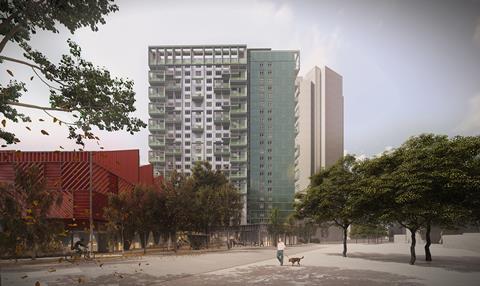
The masterplan developed since then set out plans for nearly 2,300, as well as new commercial and community spaces including a leisure centre and seven green spaces. “The residents were very keen on seeing the kind of the form of the estate staying, with the towers on the edges, and then low rise in the middle,” says Hayes. “So that’s what we’ve recreated in the master plan.” Of the three existing towers on the estate, two will be sustainably repurposed - the third, apparently, was built differently and so could not be made viable for refurbishment. The first phase, set to begin this year, will see James Riley Point, a vacant 23-storey 1960s residential tower, upgraded. The design of the retrofit project has been led by Proctor and Matthews Architects and ECD Architects. The refreshed tower will be entirely affordable, with the sub-market rent components of the development being frontloaded to act as receptacles from parts of the estate that are still inhabited, meaning remaining residents will only have to move once. Hawkins\Brown is currently working on detailed designs for phase two, known as Lund Quarter, with a submission also expected later in 2025.
The full regeneration of the Carpenters alone will take around 12 years to deliver and Heenan has an even longer horizon than that. “We are looking at the Carpenters the way the people who built the Carpenters post-war were thinking,” she says.
The successes and failures of 1960s estate development are far more obvious to us today than they were to the architects, developers and councils of the day. It may be another half century before a real judgement can be passed on what Populo is doing in Newham but for now all they can do is focus on their mission as Hayes describes it to me: “More, better.”

















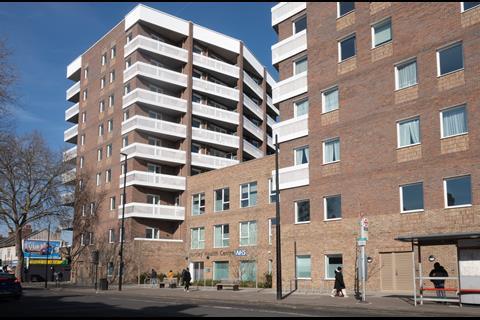
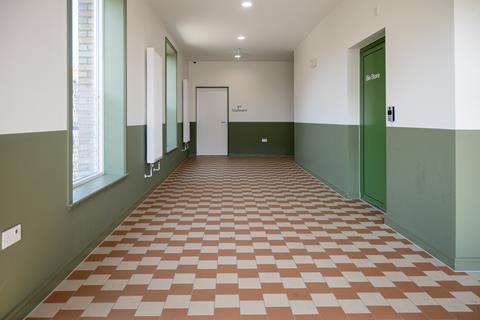

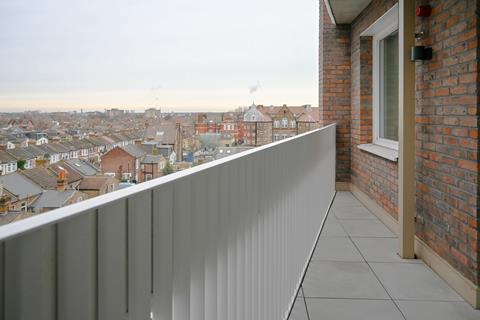







No comments yet